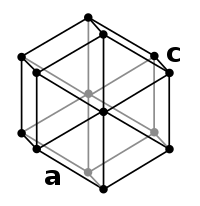
Photo from wikipedia
There is a gap of knowledge for the fate, effects and bioavailability of coated and uncoated ZnO nanoparticles (NPs) in soil. Moreover, little is known about the effects of soil… Click to show full abstract
There is a gap of knowledge for the fate, effects and bioavailability of coated and uncoated ZnO nanoparticles (NPs) in soil. Moreover, little is known about the effects of soil properties on effects of NPs on plants. In this study, the availability ZnO NPs in two soils with different organic matter content (one treated with cow manure (CM) and the other as untreated) was compared with their bulk particles. Results showed that coated and uncoated ZnO NPs can be more bioaccessible than their bulk counterpart and despite their more positive effects at low concentration (< 100mgkg-1), they were more phytotoxic for plants compared to the bulk ZnO particles at high concentration (1000mgkg-1) in the soil untreated with CM. The concentration of 1000mgkg-1 of ZnO NPs, decreased shoot dry biomass (52%) in the soil untreated with CM but increased shoot dry biomass (35%) in CM-treated soil compared to their bulk counterpart. In general, plants in the CM-treated soil showed higher Zn concentration in their tissues compared with those in untreated soil. The difference in shoot Zn concentration between CM-treated and untreated soil for NPs treatments was more than bulk particles treatment. This different percentage at 100mgkg-1 of bulk particles was 20.6% and for coated and uncoated NPs were 37% and 32%, respectively. Generally, the distribution of ZnO among Zn fractions in soil (exchangeable, the metal bound to carbonates, Fe-Mn oxides, organic matter and silicate minerals and the residual fraction) changed based on applied Zn concentration, Zn source and soil organic matter content. The root tip deformation under high concentration of NPs (1000mgkg-1 treatment) was observed by light microscopy in plants at the soil untreated with CM. It seems that root tip deformation is one of the specific effects of NPs which in turn inhibits plant growth and nutrients uptake by root. The transmission electron microcopy image showed the aggregation of NPs inside the plant cytoplasm and their accumulation adjacent to the cell membrane.
Journal Title: Ecotoxicology and environmental safety
Year Published: 2017
Link to full text (if available)
Share on Social Media: Sign Up to like & get
recommendations!